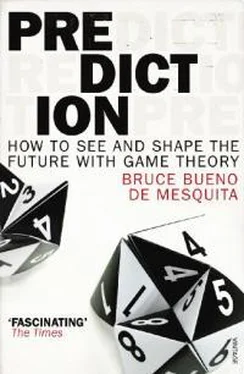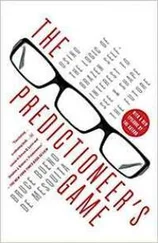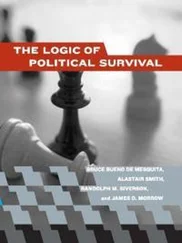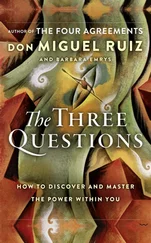The model’s maneuvers, in this as in many other situations, are designed to prevent push from coming to shove. The approach recommended through the model’s logic is indeed the very kind of bluffing we were talking about in our exploration of fundamental game theory back in Game Theory 101 and 102. We knew the board would plead to more than misdemeanors if left to its own devices, but the U.S. attorney did not and could not know that.
After months of discussion, as anticipated, the U.S. attorney responded to the pressure from the board of directors and chose sides in the ongoing war. Instead of capitulating to the hard-liners within the government, the U.S. attorney berated them in the meeting we had insisted they attend. The U.S. attorney seized the chance to reinforce his/her own initial view of what constituted a just agreement. The hard-liners were made to look mean-spirited and unrealistic, even foolish in their demands. The case was settled by the defendant’s pleading guilty to several misdemeanors and one lesser felony. This was the outcome they desired and felt was just. They believed it was out of reach, and it would have been had they gone in asking for this agreement. Going in with the final result would have left them feeling compelled to make more concessions. As it was, they got an outcome vastly better than the defendant’s management or attorneys (save one) thought possible.
This case typifies the engineering process. The board of directors, the U.S. attorney, the Department of Justice hard-liners—they are, obviously, all different people, with different upbringings, personal experiences, and beliefs about the world. But they all make choices across the same dimensions of human behavior—there are, after all, only so many options to choose from. They can look for compromises; they can try to coerce people into capitulating to them; they can surrender to their adversaries; they can lock themselves into a war against their opponents; and they can bluff doing some of the above. That’s about the full array of choices of action for any problem. The key to this case was isolating the U.S. attorney; he/she was the principal driver of the outcome. What he/she thought was “right”—whether it was or was not in any absolute sense—and what he/she wanted in ego satisfaction: these were the two essentials behind engineering the settlement. The real question of this case was how those two interests could be aligned most favorably for my client.
If I were to have brought the area-specialist mentality to this engagement, then perhaps I would have read through the thousands of pages of background produced by the armies of lawyers, perhaps I would have delved into volumes of case law, and perhaps I would have ultimately produced a brilliant argument as to why my clients deserved only misdemeanors and a minor felony. (Of course, this is not what my client hired me for, and is in fact exactly what the lawyers would have produced if the matter had landed in court.) But then, in that clash over the merits, however brilliant an argument I could have produced, despite all of my efforts, it probably wouldn’t have meant a darn thing. Because, of course, the talented government attorneys on the other side could have produced just as sparkling a case for severe felonies—and that leaves so very much to chance. No, the path to favorable resolution was in doing the work to produce an accurate understanding of the lay of the land, and then finding ways to work with it, not against it, through sequences of interaction.
The process of predictioneering does not rely on the recounting of grievances (which all too often only hardens positions). If people are congregated around an impasse, well, it’s indeed unfortunate that there’s a conflict, but the very act of congregating around it suggests that the parties are in search of some dynamic that will yield an outcome—whatever it may be—to break the stasis. Predictioneering provides a complex network of decision-making channels, valves that open and close as actions are taken or passed upon. If I offer options A, B, and C, then doors D, E, and F open, and so on exponentially (again, hence the need for the trusty computer!). Suddenly, as this network routes decisions, grounds shift, positions change, and in this case a U.S. attorney is led to a place where he/she feels both validated in his/her own views and accomplished in forcing a little heavier penalty on my client than it was apparently (but not actually) initially willing to endure.
This process involves exploiting or altering people’s perceptions of a situation by looking within the model’s round-by-round output to work out who is responsible for shifts in positions and how to counter those shifts if they have bad consequences for the client. The process is no different whether the problem is resolving Iran’s nuclear program, figuring out what al-Qaeda is likely to do, or facilitating the merger of companies. Every one of these situations involves humans who are not all that different from one another, regardless of where they go to sleep at night.
So in the next chapter I’ll look at a few current problems such as those listed above to see how we might engineer beneficial outcomes. The examples will help illustrate the potential costs of failing to see or to address what may be around the corner.
7

FAST-FORWARD THE PRESENT
ONE OF THE great benefits of being affiliated with Stanford’s Hoover Institution is the opportunity to participate in small seminars with some of the world’s most interesting scholars and policy makers. These seminars are often off the record, which means that there is the chance for frank exchanges of views on important issues of the day. The discussion during one such seminar, on the Israeli-Palestinian dispute, led me to consider how game-theory reasoning might contribute to tackling the seemingly insurmountable obstacles to peace. The approach I thought about is not a solution to the dispute, but it is a potentially useful step toward advancing the real prospect of a lasting peace.
For all of its limitations, the idea I came up with provides an example of how game-theory reasoning can nudge us in a new direction even under the most seemingly intractable circumstances. If game-theory logic can foster progress on the Israeli-Palestinian dispute, it surely will have contributed to solving one of the most important foreign policy problems of our time. With that in mind, let’s have a fresh look at Israeli-Palestinian relations. And who knows, maybe somebody reading this book can help turn the idea into reality or can point out some fatal flaw in it.
LET’S MAKE A DEAL
Land for peace and peace for land are two formulas that are doomed to failure, whether in the Middle East or anywhere else. It’s an idea that sounds sensible, so it attracts lots of attention. Ehud Barak proposed a land-for-peace deal at the July 2000 Camp David summit between him (he was Israel’s prime minister), Yasser Arafat (then president of the Palestinian Authority), and President Bill Clinton. The Oslo Accords in 1993 also were a land-for-peace deal. Barak’s Camp David plan and its later variants failed. The Roadmap for Peace, another land-for-peace arrangement, failed too. All land-for-peace or peace-for-land deals by themselves will do the same. They are no way to end violence, because neither assures either side that the other is making a lasting promise, a credible commitment.
Each promise—land for peace or peace for land—suffers from what in game theory is sometimes called a time inconsistency problem. That is, one party gives an irreversible benefit to the other party today in the hope that the other will reciprocate tomorrow. Almost certainly instead, the side getting the irreversible benefit exploits it to seek even more gains before delivering on its promises. Giving up land on the promise of peace inevitably leads to demands for more land before peace is granted. Giving peace on the promise of land later has much the same problem. The peace giver lays down its arms to show good faith, but then the land giver is free to renege, feeling no compulsion to follow through with land the opponent can no longer take. 1
Читать дальше












